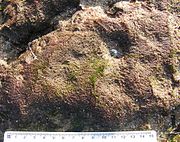Rhodothamniella: Difference between revisions
Content deleted Content added
m Open access bot: doi added to citation with #oabot. |
m CheckWiki error #38 and/or general fixes |
||
| Line 15: | Line 15: | ||
}} |
}} |
||
'''''Rhodothamniella floridula''''' is a small red [[seaweed]] detectable more easily with the feet than with the eyes.<ref>{{Cite journal |last=Knaggs |first=F.W. |last2=Conway |first2=E. |date=December 1964 |title=The life-history of |
'''''Rhodothamniella floridula''''' is a small red [[seaweed]] detectable more easily with the feet than with the eyes.<ref>{{Cite journal |last=Knaggs |first=F.W. |last2=Conway |first2=E. |date=December 1964 |title=The life-history of''Rhodochorton floridulum''(Dillwyn) Näg |url=https://www.tandfonline.com/action/showCitFormats?doi=10.1080/00071616400650091 |journal=British Phycological Bulletin |language=en |volume=2 |issue=5 |pages=339–341 |doi=10.1080/00071616400650091 |issn=0374-6534|doi-access=free }}</ref> It thrives only where sand and rock occur together: anchored to the rock, it accumulates sand to form a slightly soft irregular carpet a centimetre or so in thickness. Although the surface is a dull red colour, in cross section the appearance is of a miniature sand dune with no visible algal component. Unable to stand significant desiccation, it prefers locations from the mid-shore downwards. |
||
It is to be found on most suitable shorelines around Britain and northern Europe.<ref>{{Cite web |last=Riley |first=K. |date=2005 |title=Rhodothamniella floridula. A red seaweed |url=https://plymsea.ac.uk/id/eprint/8544/ |access-date=2023-01-29 |website=plymsea.ac.uk |language=en}}</ref> |
It is to be found on most suitable shorelines around Britain and northern Europe.<ref>{{Cite web |last=Riley |first=K. |date=2005 |title=Rhodothamniella floridula. A red seaweed |url=https://plymsea.ac.uk/id/eprint/8544/ |access-date=2023-01-29 |website=plymsea.ac.uk |language=en}}</ref> |
||
Latest revision as of 13:23, 9 January 2024
| Rhodothamniella | |
|---|---|
| Scientific classification | |
| (unranked): | Archaeplastida |
| Division: | Rhodophyta |
| Class: | Florideophyceae |
| Order: | Palmariales |
| Family: | Rhodothamniellaceae |
| Genus: | Rhodothamniella Feldmann |
| Species: | R. floridula
|
| Binomial name | |
| Rhodothamniella floridula (Dillwyn) Feldmann
| |
| Synonyms | |
| |
Rhodothamniella floridula is a small red seaweed detectable more easily with the feet than with the eyes.[1] It thrives only where sand and rock occur together: anchored to the rock, it accumulates sand to form a slightly soft irregular carpet a centimetre or so in thickness. Although the surface is a dull red colour, in cross section the appearance is of a miniature sand dune with no visible algal component. Unable to stand significant desiccation, it prefers locations from the mid-shore downwards.
It is to be found on most suitable shorelines around Britain and northern Europe.[2]
References[edit]
- ^ Knaggs, F.W.; Conway, E. (December 1964). "The life-history ofRhodochorton floridulum(Dillwyn) Näg". British Phycological Bulletin. 2 (5): 339–341. doi:10.1080/00071616400650091. ISSN 0374-6534.
- ^ Riley, K. (2005). "Rhodothamniella floridula. A red seaweed". plymsea.ac.uk. Retrieved 2023-01-29.


